Radeon HD 5000 series
The Evergreen series is a family of GPUs developed by Advanced Micro Devices for its Radeon line under the ATI brand name. It was employed in Radeon HD 5000 graphics card series and competed directly with Nvidia's GeForce 400 Series.
| Release date | September 10, 2009 |
|---|---|
| Codename | Evergreen Manhattan |
| Architecture | TeraScale 2 |
| Transistors |
|
| Cards | |
| Entry-level | 5450 5550 5570 |
| Mid-range | 5670 5750 5770 |
| High-end | 5830 5850 5870 |
| Enthusiast | 5970 |
| API support | |
| Direct3D | Direct3D 11 (feature level 11_0) [1] Shader Model 5.0 |
| OpenCL | OpenCL 1.2 [2] |
| OpenGL | OpenGL 4.5[3] |
| History | |
| Predecessor | Radeon HD 4000 series |
| Successor | Radeon HD 6000 series |
Release
The existence was spotted on a presentation slide from AMD Technology Analyst Day July 2007 as "R8xx". AMD held a press event in the USS Hornet Museum on September 10, 2009[4] and announced ATI Eyefinity multi-display technology and specifications of the Radeon HD 5800 series' variants. The first variants of the Radeon HD 5800 series were launched September 23, 2009, with the HD 5700 series launching October 12 and HD 5970 launching on November 18[5] The HD 5670, was launched on January 14, 2010, and the HD 5500 and 5400 series were launched in February 2010, completing what has appeared to be most of AMD's Evergreen GPU lineup.
Demand so greatly outweighed supply that more than two months after launch, many online retailers were still having trouble keeping the 5800 and 5900 series in stock.[6]
Architecture
This article is about all products under the Radeon HD 5000 Series brand. TeraScale 2 was introduced with this.
- A GPU implementing TeraScale 2 is found on Radeon HD 5830 and above branded products. These products have the capability to calculate double-precision floating-point format.
- A GPU implementing TeraScale 1 is found on Radeon HD 5770 and below branded products. These products have the capability to calculate only single-precision floating-point format.
- OpenGL 4.x compliance requires supporting FP64 shaders. These are implemented by emulation on some TeraScale (microarchitecture) GPUs.
Multi-monitor support
The on-die display controllers with the new brand name AMD Eyefinity were introduced with the Radeon HD 5000 Series. The entire HD 5000 series products have Eyefinity capabilities supporting three outputs. The Radeon HD 5870 Eyefinity Edition, however, supports six mini DisplayPort outputs, all of which can be simultaneously active.
Display pipeline supports xvYCC gamut and 12-bit per component output via HDMI. HDMI 1.3a output. The previous generation Radeon R700 GPUs in the Radeon HD 4000 Series only support up to LPCM 7.1 audio and no bitstream output support for Dolby TrueHD and DTS-HD Master Audio audio formats to external decoders. This feature is now supported on Evergreen family GPUs. On Evergreen family GPUs, DisplayPort outputs on board are capable of 10-bit per component output,[7] and HDMI output is capable of 12-bit per component output.
| DVI-I/VGA | DVI-I/VGA | HDMI | DisplayPort | |
|---|---|---|---|---|
| Option 1 | Active | Active | Inactive | Active |
| Option 2 | Active | Inactive | Active | Active |
Video acceleration
Unified Video Decoder (UVD2.2)[8] is present on the dies of all products and supported by AMD Catalyst 9.11 and later through DXVA 2.0 on Microsoft Windows and VDPAU on Linux and FreeBSD. The free and open-source graphics device driver#ATI/AMD also support UVD.
OpenCL (API)
OpenCL accelerates many scientific software packages up to a factor 10 or 100 and more, compared to contemporary CPUs. OpenCL 1.0 to 1.2 are supported for all Terascale 2 and 3 chips.[9]
Radeon Feature Table
The following table shows features of AMD's GPUs (see also: List of AMD graphics processing units).
| Name of GPU series | Wonder | Mach | 3D Rage | Rage Pro | Rage | R100 | R200 | R300 | R400 | R500 | R600 | RV670 | R700 | Evergreen | Northern Islands |
Southern Islands |
Sea Islands |
Volcanic Islands |
Arctic Islands/Polaris |
Vega | Navi | Big Navi | |||
|---|---|---|---|---|---|---|---|---|---|---|---|---|---|---|---|---|---|---|---|---|---|---|---|---|---|
| Released | 1986 | 1991 | 1996 | 1997 | 1998 | Apr 2000 | Aug 2001 | Sep 2002 | May 2004 | Oct 2005 | May 2007 | Nov 2007 | Jun 2008 | Sep 2009 | Oct 2010 | Jan 2012 | Sep 2013 | Jun 2015 | Jun 2016 | Jun 2017 | Jul 2019 | Nov 2020 | |||
| Marketing Name | Wonder | Mach | 3D Rage | Rage Pro | Rage | Radeon 7000 | Radeon 8000 | Radeon 9000 | Radeon X700/X800 | Radeon X1000 | Radeon HD 2000 | Radeon HD 3000 | Radeon HD 4000 | Radeon HD 5000 | Radeon HD 6000 | Radeon HD 7000 | Radeon Rx 200 | Radeon Rx 300 | Radeon RX 400/500 | Radeon RX Vega/Radeon VII(7nm) | Radeon RX 5000 | Radeon RX 6000 | |||
| AMD support | |||||||||||||||||||||||||
| Kind | 2D | 3D | |||||||||||||||||||||||
| Instruction set | Not publicly known | TeraScale instruction set | GCN instruction set | RDNA instruction set | |||||||||||||||||||||
| Microarchitecture | TeraScale 1 | TeraScale 2 (VLIW5) | TeraScale 3 (VLIW4) | GCN 1st gen | GCN 2nd gen | GCN 3rd gen | GCN 4th gen | GCN 5th gen | RDNA | RDNA 2 | |||||||||||||||
| Type | Fixed pipeline[lower-alpha 1] | Programmable pixel & vertex pipelines | Unified shader model | ||||||||||||||||||||||
| Direct3D | N/A | 5.0 | 6.0 | 7.0 | 8.1 | 9.0 11 (9_2) |
9.0b 11 (9_2) |
9.0c 11 (9_3) |
10.0 11 (10_0) |
10.1 11 (10_1) |
11 (11_0) | 11 (11_1) 12 (11_1) |
11 (12_0) 12 (12_0) |
11 (12_1) 12 (12_1) |
11 (12_2) 12 (12_2) | ||||||||||
| Shader model | N/A | 1.4 | 2.0+ | 2.0b | 3.0 | 4.0 | 4.1 | 5.0 | 5.1 | 5.1 6.3 |
6.4 | 6.5 | |||||||||||||
| OpenGL | N/A | 1.1 | 1.2 | 1.3 | 2.0[lower-alpha 2] | 3.3 | 4.5 (on Linux + Mesa 3D: 4.5 with FP64 HW support, 4.3 without)[3][10][11][lower-alpha 3] | 4.6 (on Linux: 4.6 (Mesa 20.0)) | |||||||||||||||||
| Vulkan | N/A | 1.0 (Win 7+ or Mesa 17+) |
1.2 (Adrenalin 20.1, Linux Mesa 20.0) | ||||||||||||||||||||||
| OpenCL | N/A | Close to Metal | 1.1 | 1.2 | 2.0 (Adrenalin driver on Win7+) (on Linux: 1.2 with Mesa 3D, 2.1 with AMD drivers or AMD ROCm) |
? | 2.1 [12] | ||||||||||||||||||
| HSA | N/A | ? | |||||||||||||||||||||||
| Video decoding ASIC | N/A | Avivo/UVD | UVD+ | UVD 2 | UVD 2.2 | UVD 3 | UVD 4 | UVD 4.2 | UVD 5.0 or 6.0 | UVD 6.3 | UVD 7[13][lower-alpha 4] | VCN 2.0[13][lower-alpha 4] | VCN 3.0[14] | ||||||||||||
| Video encoding ASIC | N/A | VCE 1.0 | VCE 2.0 | VCE 3.0 or 3.1 | VCE 3.4 | VCE 4.0[13][lower-alpha 4] | |||||||||||||||||||
| Fluid Motion | |||||||||||||||||||||||||
| Power saving | ? | PowerPlay | PowerTune | PowerTune & ZeroCore Power | ? | ||||||||||||||||||||
| TrueAudio | N/A | Via dedicated DSP | Via shaders | ? | |||||||||||||||||||||
| FreeSync | N/A | 1 2 | |||||||||||||||||||||||
| HDCP[lower-alpha 5] | ? | 1.4 | 1.4 2.2 |
1.4 2.2 2.3 |
? | ||||||||||||||||||||
| PlayReady[lower-alpha 5] | N/A | 3.0 | 3.0 | ? | |||||||||||||||||||||
| Supported displays[lower-alpha 6] | 1–2 | 2 | 2–6 | ? | |||||||||||||||||||||
| Max. resolution | ? | 2–6 × 2560×1600 |
2–6 × 4096×2160 @ 60 Hz |
2–6 × 5120×2880 @ 60 Hz |
3 × 7680×4320 @ 60 Hz[15] |
? | |||||||||||||||||||
/drm/radeon[lower-alpha 7] |
N/A | ||||||||||||||||||||||||
/drm/amdgpu[lower-alpha 7] |
N/A | Experimental[16] | |||||||||||||||||||||||
- The Radeon 100 Series has programmable pixel shaders, but do not fully comply with DirectX 8 or Pixel Shader 1.0. See article on R100's pixel shaders.
- These series do not fully comply with OpenGL 2+ as the hardware does not support all types of non-power of two (NPOT) textures.
- OpenGL 4+ compliance requires supporting FP64 shaders and these are emulated on some TeraScale chips using 32-bit hardware.
- The UVD and VCE were replaced by the Video Core Next (VCN) ASIC in the Raven Ridge APU implementation of Vega.
- To play protected video content, it also requires card, operating system, driver, and application support. A compatible HDCP display is also needed for this. HDCP is mandatory for the output of certain audio formats, placing additional constraints on the multimedia setup.
- More displays may be supported with native DisplayPort connections, or splitting the maximum resolution between multiple monitors with active converters.
- DRM (Direct Rendering Manager) is a component of the Linux kernel. Support in this table refers to the most current version.
Desktop products
| Model | Launch | Code name | Fab (nm) | Transistors (million) | Die size (mm2) | Bus interface | Clock rate | Core config[lower-alpha 1] | Fillrate | Memory | Processing power (GFLOPS) |
TDP (Watts)[lower-alpha 2] | Crossfire Support | API support (version) | Release Price (USD) | |||||||||
|---|---|---|---|---|---|---|---|---|---|---|---|---|---|---|---|---|---|---|---|---|---|---|---|---|
| Core (MHz) | Memory (MHz) | Pixel (GP/s) | Texture (GT/s) | Size (MB) | Bandwidth (GB/s) | Bus type | Bus width (bit) | Single precision | Double precision | Idle | Max. | Direct3D | OpenGL | OpenCL | ||||||||||
| Radeon HD 5450 | Feb 4, 2010 | Cedar PRO | 40 | 292 | 59 | PCIe 2.1 x16 PCI PCIe 2.1 x1 |
650 650 650 |
400 800 800 |
80:8:4 | 2.6 | 5.2 | 512 1024 2048 |
6.4 12.8 |
DDR2 DDR3 |
64 | 104 | N/A | 6.4 | 19.1 | No | 11.3 (11_0) |
4.5 | 1.2 | ~50 |
| Radeon HD 5550 | Feb 9, 2010 | Redwood LE | 627 | 104 | PCIe 2.1 x16 | 550 550 550 |
320:16:8 | 4.4 | 8.8 | 12.8 25.6 51.2 |
DDR2 GDDR3 GDDR5 |
128 | 352 | 10 | 39 | ~70 | ||||||||
| Radeon HD 5570 | Redwood PRO | 650 650 |
400 900 |
400:20:8 | 5.2 | 13.0 | 12.8 28.8 57.6 |
520 | 80 | |||||||||||||||
| Radeon HD 5610 | May 14, 2011 | 650 | 500 | 1024 | 16.0 | GDDR3 | ||||||||||||||||||
| Radeon HD 5670 | Jan 14, 2010 | Redwood XT | 775 775 |
800 1000 |
6.2 | 15.5 | 512 1024 2048 |
25.6 64.0 |
GDDR3 GDDR5 |
620 | 15 | 64 | 4-way Crossfire | 99 | ||||||||||
| Radeon HD 5750 | Oct 13, 2009 | Juniper PRO | 1040 | 170 | 700 700 |
1150 1150 |
720:36:16 | 11.2 | 25.2 | 512 1024 |
73.6 | GDDR5 | 1008 | 16 | 86 | 129 | ||||||||
| Radeon HD 5770 | Juniper XT | 850 850 |
1200 1200 |
800:40:16 | 13.6 | 34.0 | 76.8 | 1360 | 18 | 108 | 159 | |||||||||||||
| Radeon HD 5830 | Feb 25, 2010 | Cypress LE | 2154 | 334 | 800 | 1000 | 1120:56:16 | 12.8 | 44.8 | 1024 | 128.0 | 256 | 1792 | 358.4 | 25 | 175 | 239 | |||||||
| Radeon HD 5850 | Sep 30, 2009 | Cypress PRO | 725 725 |
1000 1000 |
1440:72:32 | 23.2 | 52.2 | 1024 2048 |
2088 | 417.6 | 27 | 151 | 259 | |||||||||||
| Radeon HD 5870 | Sep 23, 2009 | Cypress XT | 850 850 |
1200 1200 |
1600:80:32 | 27.2 | 68.0 | 153.6 | 2720 | 544 | 188 228 |
379 | ||||||||||||
| Radeon HD 5870 Eyefinity Edition[lower-alpha 3][17] |
Mar 11, 2010 | 850 | 1200 | 2048 | 228 | 479 | ||||||||||||||||||
| Radeon HD 5970 | Nov 18, 2009 | Hemlock XT | 2154×2 | 334×2 | 725 725 |
1000 1000 |
1600:80:32×2 | 46.4 | 116.0 | 1024×2 2048×2 |
128×2 | 256×2 | 4640 | 928 | 51 | 294 | 2-way Crossfire | 599 | ||||||
| Model | Launch | Code name | Fab (nm) | Transistors (Million) | Die Size (mm²) | Bus interface | Core (MHz) | Memory (MHz) | Core config[lower-alpha 1] | Pixel (GP/s) | Texture (GT/s) | Size (MB) | Bandwidth (GB/s) | Bus type | Bus width (bit) | Single Precision | Double Precision | Idle | Max. | Crossfire Support | Direct3D | OpenGL | OpenCL | Release Price (USD) |
| Clock rate | Fillrate | Memory> | Processing power (GFLOPS) |
TDP (W)[lower-alpha 2] | API support (version) | |||||||||||||||||||
- Unified Shaders : Texture Mapping Units : Render Output Units
- The TDP is reference design TDP values from AMD. Different non-reference board designs from vendors may lead to slight variations in actual TDP.
- All chips feature AMD Eyefinity, but the Radeon HD 5870 Eyefinity Edition card also have six mini DisplayPort outputs, all of which can be simultaneously active.
Radeon HD 5900
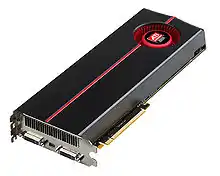
Codenamed Hemlock, the Radeon HD 5900 series was announced on October 12, 2009, starting with the HD 5970.[18] The Radeon HD 5900 series utilizes two Cypress graphics processors and a third-party PCI-E bridge. Similar to Radeon HD 4800 X2 series graphics cards; however, AMD has abandoned the use of X2 moniker for dual-GPU variants starting with Radeon HD 5900 series, making it the only series within the Evergreen GPU family to have two GPUs on one PCB.
Radeon HD 5800
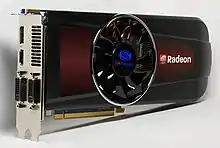
Codenamed Cypress, the Radeon HD 5800 series was announced on September 23, 2009. Products included Radeon HD 5850 and Radeon HD 5870. The launching model of Radeon HD 5870 can support three display outputs at most, and one of these has to support DisplayPort. In terms of overall performance, the 5870 comes in between the GTX 470 and GTX 480 from rival company Nvidia, being closer to the GTX 480 than the GTX 470.[19] An Eyefinity 6 edition of Radeon HD 5870 was released, with 2 GiB GDDR5 memory, supporting six simultaneous displays, all to be connected to one of the mini DisplayPort outputs and all supporting this connection natively to not require additional hardware. The Radeon HD 5870 has 1600 usable shader processors, while the Radeon HD 5850 has 1,440 usable stream cores, as 160 out of the 1,600 total cores are disabled during product binning which detects potentially defective areas of the chip. A Radeon HD 5830 was released on February 25, 2010. The Radeon HD 5830 has 1,120 usable stream cores and a standard core clock of 800 MHz.
Radeon HD 5700
The codename for the 5700 GPU was Juniper and it was exactly half of Cypress. Half the shader engines, half the memory controllers, half the ROPs, half the TMUs, half everything. The 5750 had one shader engine disabled (of 10), so had 720 stream processors, while the 5770 had all ten enabled. Additionally, the 5750 ran at 700 MHz and a lower voltage, while the 5770 used more power, but ran at 850 MHz. Both cards were normally found with 1 GB of GDDR5 memory, but 512 MB variants did exist, performance suffering somewhat.
Radeon HD 5600
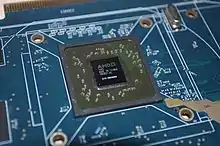
Codenamed Redwood XT, the 5600 series has all five of Redwood's shader engines enabled. As each of them has 80 VLIW-5 units, this gave it 400 stream processors. Reference clocks were 775 MHz for all 5600s, while memory clocks varied between OEMs, as did the use of DDR3 and GDDR5 memory, the latter being twice as fast.
Radeon HD 5500
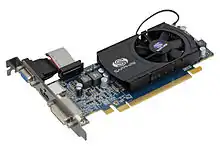
The Radeon HD 5570 was released on February 9, 2010, using the Redwood XT GPU as seen in the 5600 series. At first release was limited to DDR3 memory, but later, ATI added support for GDDR5 memory. One more variant, with only 320 stream cores, is available and Radeon HD 5550 was suggested as the product name. 5570s and 5550s were available with GDDR5, GDDR3 and DDR2 memory. The 5550 variant disabled one shader engine, so had only 320 stream processors (4 engines, 80 VLIW-5 units each).
All reference board designs of the Radeon HD 5500 series are half-height, making them suitable for a low profile form factor chassis.
Radeon HD 5400
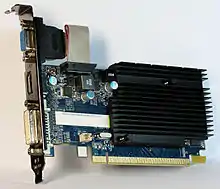
Codenamed Cedar,[20] the Radeon HD 5400 series was announced on February 4, 2010, starting with the HD 5450. The Radeon HD 5450 has 80 stream cores, a core clock of 650 MHz, and 800 MHz DDR2 or DDR3 memory. The 5400 series is designed to assume a low-profile card size.
Mobile products
Graphics device drivers
AMD's proprietary graphics device driver "Catalyst"
AMD Catalyst is being developed for Microsoft Windows and Linux. As of July 2014, other operating systems are not officially supported. This may be different for the AMD FirePro brand, which is based on identical hardware but features OpenGL-certified graphics device drivers.
AMD Catalyst supports of course all features advertised for the Radeon brand.
Free and open-source graphics device driver "Radeon"
The free and open-source drivers are primarily developed on Linux and for Linux, but have been ported to other operating systems as well. On HD5000, the driver using following six parts:
- Linux kernel component DRM
- Linux kernel component KMS driver: basically the device driver for the display controller in kernel, called "radeon".
- user-space component libDRM: basically one of 3d drivers. The HD5000 series are using the "r600g" driver.
- user-space component in Mesa 3D;
- a special and distinct 2D graphics device driver for X.Org Server; with this card, EXA is used instead of Glamor
The free and open-source "Radeon" graphics driver supports most of the features implemented into the Radeon line of GPUs.[21]
The free and open-source "Radeon" graphics device drivers are not reverse engineered, but based on documentation released by AMD.[22]
References
- "AMD Radeon™ Software Support for Legacy Graphics Products". AMD. Retrieved 2018-04-21.
- "AMD Catalyst™ Software Suite Version 12.4 Release Notes". 2012. Archived from the original on 2012-04-26. Retrieved 2018-04-20.
- "AMD Radeon Software Crimson Edition Beta". AMD. Retrieved 2018-04-20.
- "AMD is driving graphics to the edge with Eyefinity powering the SimCraft APEX sc830". SimCraft insider. 2009-09-11.
- ATI Radeon HD 5970 Press Release
- "O 5800, 5800, Wherefor Art Thou 5800?". [H]ArdOCP. 2009-11-10.
- DirectX 11 in the Open: ATI Radeon HD 5870 Review Archived 2009-09-27 at the Wayback Machine
- Unified Video Decoder#UVD-enabled GPUs
- https://www.khronos.org/conformance/adopters/conformant-products
- "Mesamatrix". mesamatrix.net. Retrieved 2018-04-22.
- "RadeonFeature". X.Org Foundation. Retrieved 2018-04-20.
- "AMD Radeon RX 6800 XT Specs". TechPowerUp. Retrieved 1 January 2021.
- Killian, Zak (22 March 2017). "AMD publishes patches for Vega support on Linux". Tech Report. Retrieved 23 March 2017.
- Larabel, Michael (15 September 2020). "AMD Radeon Navi 2 / VCN 3.0 Supports AV1 Video Decoding". Phoronix. Retrieved 1 January 2021.
- "Radeon's next-generation Vega architecture" (PDF). Radeon Technologies Group (AMD). Archived from the original (PDF) on 2018-09-06. Retrieved 13 June 2017.
- Larabel, Michael (7 December 2016). "The Best Features of the Linux 4.9 Kernel". Phoronix. Retrieved 7 December 2016.
- Angelini, Chris; Abi-Chahla, Fedy (September 23, 2009). "ATI Radeon HD 5870: DirectX 11, Eyefinity, And Serious Speed". Tom's Hardware. Bestofmedia Network. p. 8. Retrieved October 9, 2009.
- Dual-GPU ATI Radeon HD 5970 released
- http://www.techspot.com/review/283-geforce-gtx-400-vs-radeon-hd-5800/GTX 480 and GTX 470 Review
- "AMD Financial Analyst Day 2009 Codename Decoder". AMD. 2009-10-11.
- "RadeonFeature". Xorg.freedesktop.org. Retrieved 2014-07-06.
- "AMD Developer Guideds". Archived from the original on 2013-07-16.